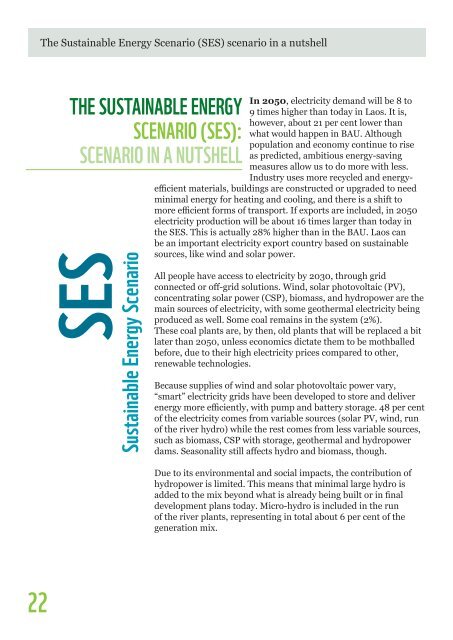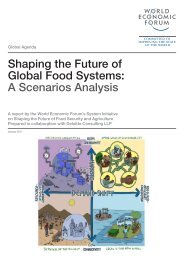Vision 2050
wwf_greater_mekong_power_sector_vision_2050
wwf_greater_mekong_power_sector_vision_2050
Create successful ePaper yourself
Turn your PDF publications into a flip-book with our unique Google optimized e-Paper software.
The Sustainable Energy Scenario (SES) scenario in a nutshell<br />
THE SUSTAINABLE ENERGY<br />
SCENARIO (SES):<br />
SCENARIO IN A NUTSHELL<br />
SES<br />
Sustainable Energy Scenario<br />
In <strong>2050</strong>, electricity demand will be 8 to<br />
9 times higher than today in Laos. It is,<br />
however, about 21 per cent lower than<br />
what would happen in BAU. Although<br />
population and economy continue to rise<br />
as predicted, ambitious energy-saving<br />
measures allow us to do more with less.<br />
Industry uses more recycled and energyefficient<br />
materials, buildings are constructed or upgraded to need<br />
minimal energy for heating and cooling, and there is a shift to<br />
more efficient forms of transport. If exports are included, in <strong>2050</strong><br />
electricity production will be about 16 times larger than today in<br />
the SES. This is actually 28% higher than in the BAU. Laos can<br />
be an important electricity export country based on sustainable<br />
sources, like wind and solar power.<br />
All people have access to electricity by 2030, through grid<br />
connected or off-grid solutions. Wind, solar photovoltaic (PV),<br />
concentrating solar power (CSP), biomass, and hydropower are the<br />
main sources of electricity, with some geothermal electricity being<br />
produced as well. Some coal remains in the system (2%).<br />
These coal plants are, by then, old plants that will be replaced a bit<br />
later than <strong>2050</strong>, unless economics dictate them to be mothballed<br />
before, due to their high electricity prices compared to other,<br />
renewable technologies.<br />
Because supplies of wind and solar photovoltaic power vary,<br />
“smart” electricity grids have been developed to store and deliver<br />
energy more efficiently, with pump and battery storage. 48 per cent<br />
of the electricity comes from variable sources (solar PV, wind, run<br />
of the river hydro) while the rest comes from less variable sources,<br />
such as biomass, CSP with storage, geothermal and hydropower<br />
dams. Seasonality still affects hydro and biomass, though.<br />
Due to its environmental and social impacts, the contribution of<br />
hydropower is limited. This means that minimal large hydro is<br />
added to the mix beyond what is already being built or in final<br />
development plans today. Micro-hydro is included in the run<br />
of the river plants, representing in total about 6 per cent of the<br />
generation mix.<br />
22




